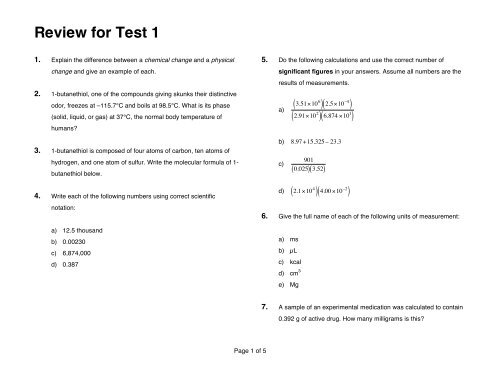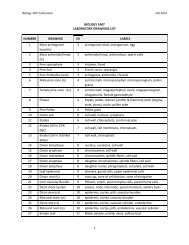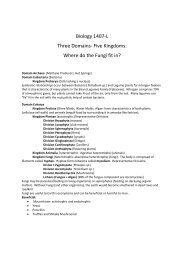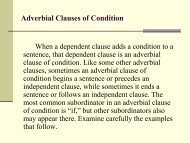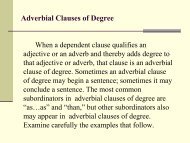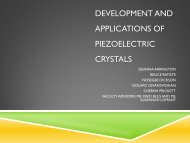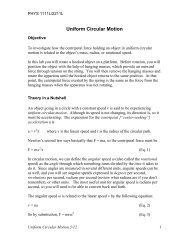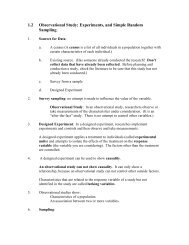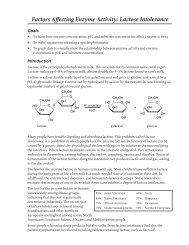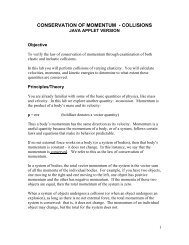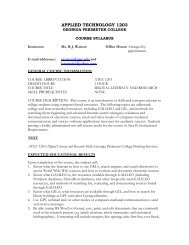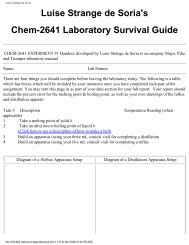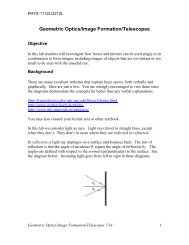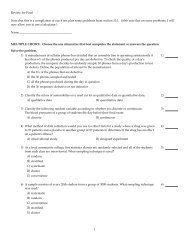Test 1 review
Test 1 review
Test 1 review
- No tags were found...
Create successful ePaper yourself
Turn your PDF publications into a flip-book with our unique Google optimized e-Paper software.
8. What is the volume of a gold nugget that weighs 2.20 kg? Thedensity of gold is 19.3 g/cm 3 .9. Which is colder, –10°F or –10°C?10. Determine the number of protons, electrons, and neutrons in atoms!of the following isotopes:a) fluorine-19b)1532 Pc) A silver atom with a mass of 115 u15. Microwave radiation has a wavelength on the order of 1.0 cm.Calculate the frequency and the energy of a single photon of thisradiation.16. A photon was absorbed by a hydrogen atom in its ground state,and the electron was promoted to the second orbit. When theexcited atom returned to its ground state, radiation was emitted.Calculate the wavelength of the radiation.17. Write the electronic configuration of each of the following elements.You may use the long or short form. Next, indicate how manyvalence electrons the element has. Finally, indicate how manyunpaired electrons the element has.11. How many moles of sodium atoms are in a 50.0 g sample ofsodium?12. How many moles of carbon are contained in 2.50 mol ofnitrophenol (C 6 H 5 NO 3 )?a) calciumb) Asc) gold13. How many grams of chlorine are contained in 1.50 mol oftetrachloromethane (CCl 4 )?14. A sample of a pure element has a mass of 70.53 g. It is known thatthe sample contains 1.324 x 10 24 atoms. What element is it? (hint:find the atomic weight of the sample and match it on the periodictable).18. Arrange the following elements in order of increasing size.a) Te, S, Seb) Na – , Na, Na +19. Arrange the following elements in order of increasing ionizationenergy?a) Ca, Sr, Bab) S 2– , S, S 2+Page 2 of 5
20. Identify the element whose ions have the following electronicconfigurations:a) a 2+ ion with [Ar]3d 9b) a 1+ ion with [Xe]6s 2 4f 14 5d 1021. How many valence electrons do the following elements have?a) potassiumb) element 30c) PbPage 3 of 5
Answers:1. A physical change is a change that does not affect the chemicalmakeup of the substance. The melting of ice to give liquid is anexample of a physical change. The water has changed forms, butnot its makeup.A chemical change is a change in the chemical makeup of asubstance. The rusting of a nail is a chemical change because theiron combines with oxygen in the air to give rust, a new compoundwith new properties.2. At 37°C, 1-butanethiol is a liquid.3. C 4 H 10 S4. a) 1.25 x 10 4b) 2.30 x 10 –3c) 6.874 x 10 6d) 3.87 x 10 –15. a) 0.044b) 1.0c) 1.0 x 10 4d) 8.4 x 10 2 but I will accept 840!!!!6. a. millisecond7.8.b. microliterc. kilocaloried. cubic centimetere. megagram( 0.392g) ( 1000 mg g) = 392 mgv = m d = 2.20kg( )( ) 1000 g kg19.3 g cm 3 = 114 cm 39. Convert one of the two temperatures into the other unit. Iʼvechosen to convert –10°C to °F:°F = 9 °C + 325°F = 9 5 °C + 32 = 9 (5 –10 ) + 32 = 14°FWhich is colder, –10°F or –10°C=14°F? Obviously –10°F is colder.10. a) 9 p, 9 e – , 10 n11.12.!b) 15 p, 15 e – , 17 nc) 47 p, 47 e – , 68 n" 50.0 %$ ' = 2.17 mol# 22.99&( 2.50) ( 6) = 15.0 molPage 4 of 5!
!!!!13.( 1.50) ( 4) ( 35.45) = 213 g19. a) Ba, Sr, Cab) S 2– , S, S 2+70.5314.= 32.07 u which is sulfur! # 1.324 "10 24 &%$ 6.02 "10 23 (20. a) Copper'b) Thallium15.! " = c # = 3.0 $1010 cm s= 3.0 $10 10 Hz1.0cm21. a) 1E = h" = ( 6.626 #10 –34 J $ s) ( 3.0 #10 10 s –1) = 2.0 #10 –23 Jb) 2c) 416. Use the Rydberg equation:1" = ( R $ 1H )&2n # 1 ') = 1.096776 *10 7 m –1 $ 12% 1 n 2( )&(1 2 # 1 '% 2 2 ) = 8.225820 *10 6 m –1(1" =8.225820 #10 6 m –1 = 1.215684 #10–7 m17. a) 1s 2 2s 2 2p 6 3s 2 3p 6 4s 2 or [Ar]4s 2 , 2, 0b) 1s 2 2s 2 2p 6 3s 2 3p 6 4s 2 3d 10 4p 3 or [Ar]4s 2 3d 10 4p 3 , 5, 3c) 1s 2 2s 2 2p 6 3s 2 3p 6 4s 2 3d 10 4p 6 5s 2 4d 10 5p 6 6s 1 4f 14 5d 10 or[Xe]6s 1 4f 14 5d 10 , 1, 118. a) S, Se, TePage 5 of 5


